�
Analyzing
Social
Networks
2
Analyzing
Social
Networks
Stephen P Borgatti
Martin G Everett
Jeffrey C Johnson
3
�
SAGE Publications Ltd
1 Oliver’s Yard
55 City Road
London EC1Y 1SP
SAGE Publications Inc.
2455 Teller Road
Thousand Oaks, California 91320
SAGE Publications India Pvt Ltd
B 1/I 1 Mohan Cooperative Industrial Area
Mathura Road
New Delhi 110 044
SAGE Publications Asia-Pacific Pte Ltd
3 Church Street
#10-04 Samsung Hub
Singapore 049483
Editor: Jai Seaman
Assistant editor: Anna Horvai
Production editor: Ian Antcliff
Copyeditor: Richard Leigh
Proofreader: Sharika Sharma
Indexer: Silvia Benvenuto
Marketing manager: Ben Griffin-Sherwood
Cover design: Lisa Harper
Typeset by: C&M Digitals (P) Ltd, Chennai, India Printed in Great Britain by MPG
Printgroup, UK
© Stephen P Borgatti, Martin G Everett and Jeffrey C Johnson 2013
4
�
First published 2013
Apart from any fair dealing for the purposes of research or private study, or
criticism or review, as permitted under the Copyright, Designs and Patents Act,
1988, this publication may be reproduced, stored or transmitted in any form, or by
any means, only with the prior permission in writing of the publishers, or in the
case of reprographic reproduction, in accordance with the terms of licences issued
by the Copyright Licensing Agency. Enquiries concerning reproduction outside
those terms should be sent to the publishers.
Library of Congress Control Number: 2012950169
British Library Cataloguing in Publication data
A catalogue record for this book is available from the British Library
ISBN 978-1-4462-4740-2
ISBN 978-1-4462-4741-9 (pbk)
5
�
Contents
Preface
1 Introduction
2 Mathematical Foundations
3 Research Design
4 Data Collection
5 Data Management
6 Multivariate Techniques Used in Network Analysis
7 Visualization
8 Testing Hypotheses
9 Characterizing Whole Networks
10 Centrality
11 Subgroups
12 Equivalence
13 Analyzing Two-Mode Data
14 Large Networks
15 Ego Networks
References
Index
6
�
Preface
Welcome to the world of social network analysis. This book is intended as a
general introduction to doing network research. The focus is on methodology, from
research design and data collection to data analysis. Of course, since methodology
and theory are deeply intertwined, this book is also about network theory. What it is
not is a survey of empirical research on social networks.
the
book’s
The book is also not meant to be overly technical. We try not to simplify to the
point of misleading, but, when forced to make a choice, we have opted for
intelligibility and transmitting the spirit of an idea. In each case, however, we
provide pointers to the appropriate technical literature so that the reader can get a
fuller picture if desired.
Doing network analysis implies using network analysis software. A number of
packages exist, including UCINET (Borgatti, Everett and Freeman, 2002) and Pajek
(Batagelj and Mrvar, 1998). As two of the authors of UCINET are authors of this
book, we use UCINET for most of our examples. However, we do not intend this
book to be a tutorial on UCINET. This means we focus on generic data analysis
issues and do not give detailed UCINET-specific instructions. For those interested,
however,
website
(https://sites.google.com/site/analyzingsocialnetworks/) gives detailed information
on how all of the UCINET examples are done. The one exception to all of this is
Chapter 5, which is much more UCINET-focused than the rest of the book.
One of the issues we faced in writing this book was how to keep it down to a
reasonable size and maintain an understandable flow. We wanted to write a guide
rather than an encyclopedia. As a result, we had to leave some things out. In
general, our approach to this was to include only methods and concepts that are in
demand and tend to be useful in a variety of settings. For example, although the k-
plex (Seidman and Foster, 1978) is one of our favorite network concepts, we left it
out of the chapter on subgroups because, in general, other approaches tend to be
more practical. Similarly, in the chapter on centrality, we successfully resisted the
temptation to present even a small fraction of all the measures that are available in
the literature.
Throughout the book, we use empirical examples to illustrate the material.
Because social networks are studied in a variety of traditional academic
disciplines, we draw our examples from a wide variety of fields, including
anthropology, sociology, management, and health care.
The book consists of 15 chapters that, in our minds at least, are logically grouped
into four sections. The first section consists of an introduction (Chapter 1) and
some mathematical foundations (Chapter 2). Chapter 1 lays out our perspective on
the network research enterprise as a whole. It discusses the kinds of things we try
7
�
to explain, along with the main approaches to explaining them. Chapter 2 reviews –
in very simple terms – some of the basic concepts in graph theory and matrix
algebra. A reader familiar with network analysis could skip these two chapters, but
we think it advisable to familiarize yourself with our notation and terminology.
The next section has six chapters which are all about research methods. Chapter
3, on research design, is about the choices we make in setting up a study to
investigate a given research question. Some of it applies to social science research
in general, but much of it presents issues that are specific to social network
analysis, such as the special challenges to respondent privacy. A key concept
introduced here is the distinction between whole-network research designs and
personal-network research designs. Chapter 4 discusses different options for the
collection of network data, focusing specifically on survey methods for full
network designs. Chapter 5 is about the data manipulations we often do to prepare
network data for different analyses. Because it also discusses the importing and
exporting of data, this chapter is more closely tied to UCINET than any other
chapter. Chapter 6 is about fundamental exploratory multivariate techniques that are
not specifically designed for social network analysis but are often used as part of
the analysis process. Chapter 7 is about ways of visualizing network data in order
to reveal patterns. Finally, Chapter 8 is about statistical techniques for testing
hypotheses with network data. These are techniques specifically tailored for the
special challenges of network data, such as non-independence of observations. The
first part of the chapter is about using permutation-based versions of standard
techniques such as correlation and regression. The second part is about exponential
random graph and SIENA models. These techniques are not available in UCINET,
and the statistical underpinnings of the models are far outside the scope of this
book. However, we have included a brief introduction so that the reader is at least
familiar in the broadest terms with these options and can then decide whether to
explore them further.
The third section of the book is about the core concepts and measures of network
analysis. Chapter 9 discusses measures at the whole-network level of analysis,
such as the density of ties and the degree of clustering. Chapter 10 is about
measures of node centrality, which can be seen as characterizing each node’s
position in a network. Chapter 11 is about definitions and methods of detecting
groups (sometimes called ‘clusters’ or ‘communities’) within a network. Chapter
12 discusses ways of conceptualizing and measuring structural similarities in how
nodes are connected in the network.
The final section of the book consists of three cross-cutting chapters organized
around different kinds of data. Chapter 13 is about methods of analyzing affiliation-
type data, as when we have persons’ memberships in groups. Chapter 14 provides a
set of heuristics useful in processing large networks, such as ways of breaking
down the problem into a series of smaller ones, or changing the problem to analyze
ties among clusters of nodes. Finally, Chapter 15 is concerned with designing,
collecting and analyzing ego network data. We note that there is no chapter devoted
8
�
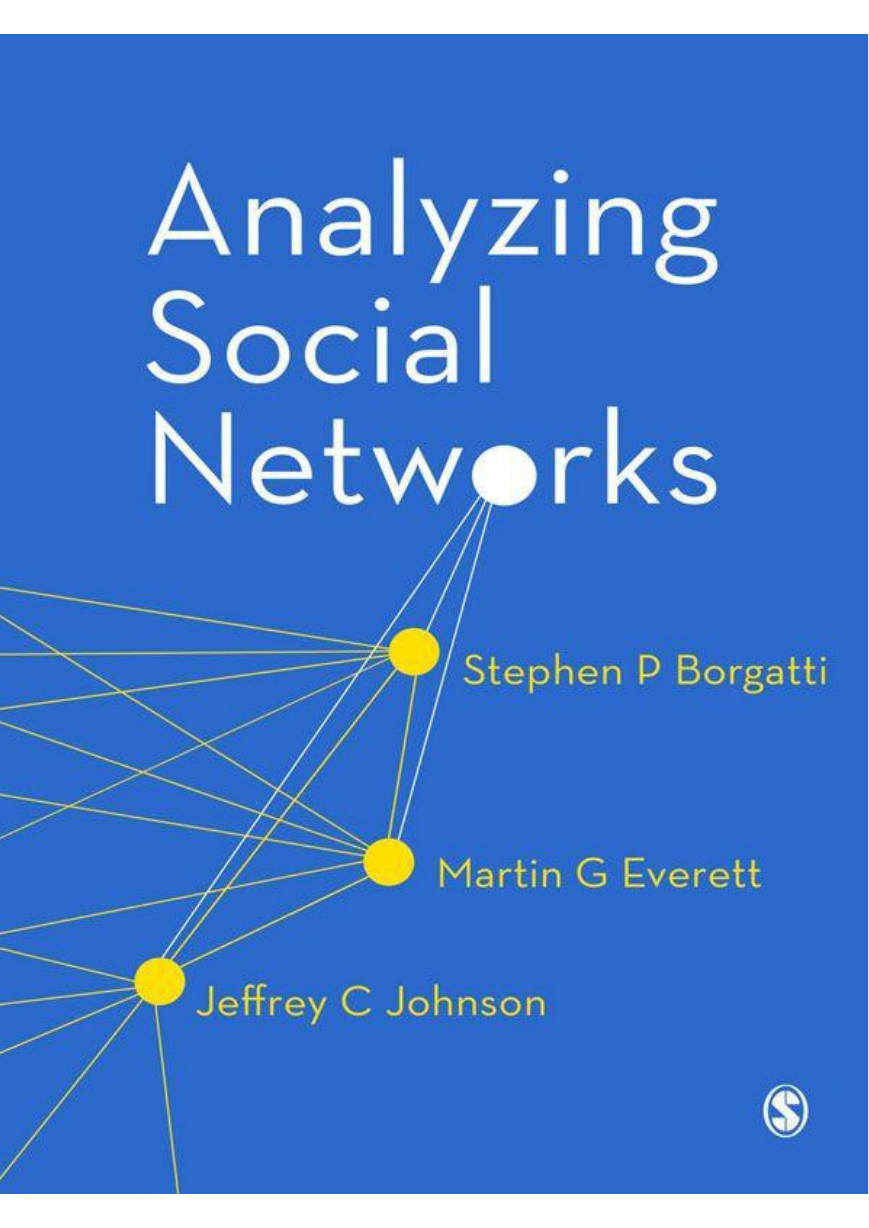

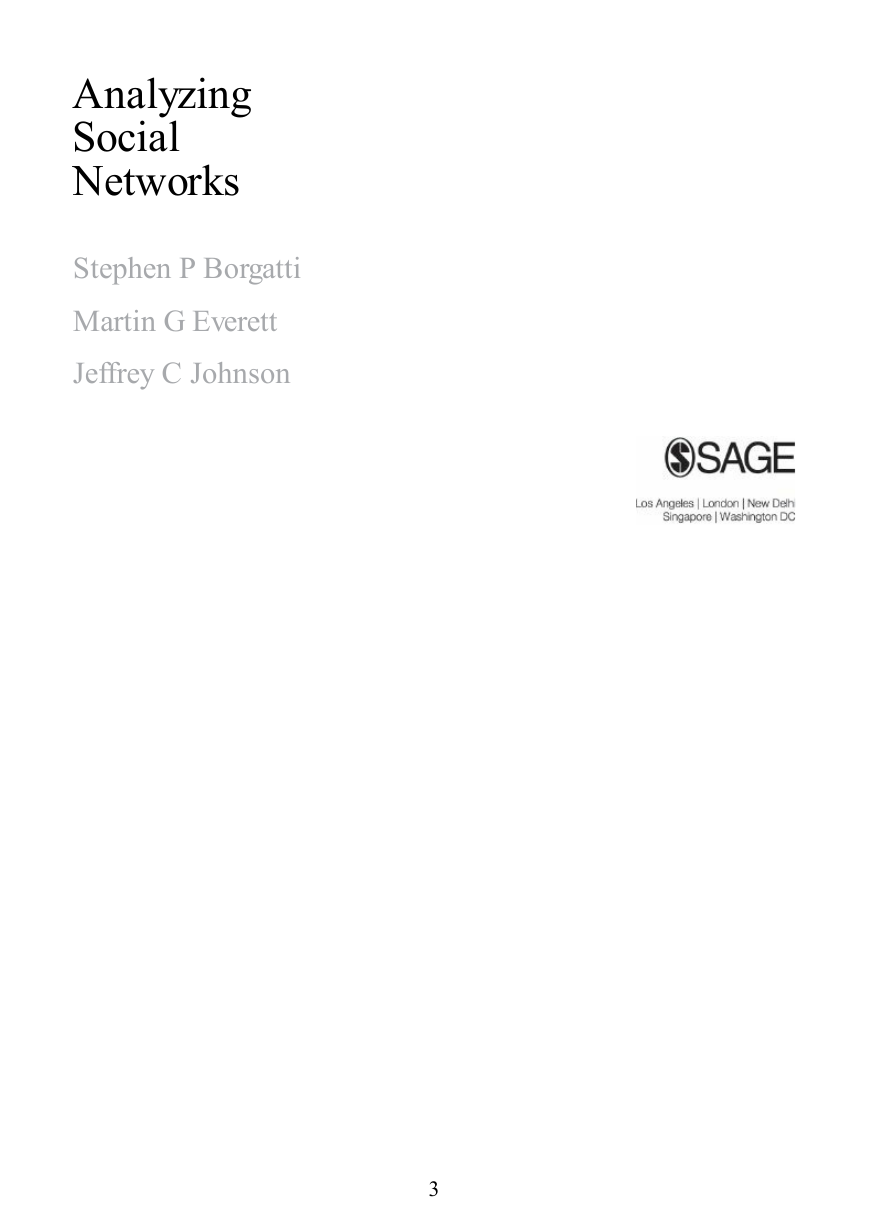


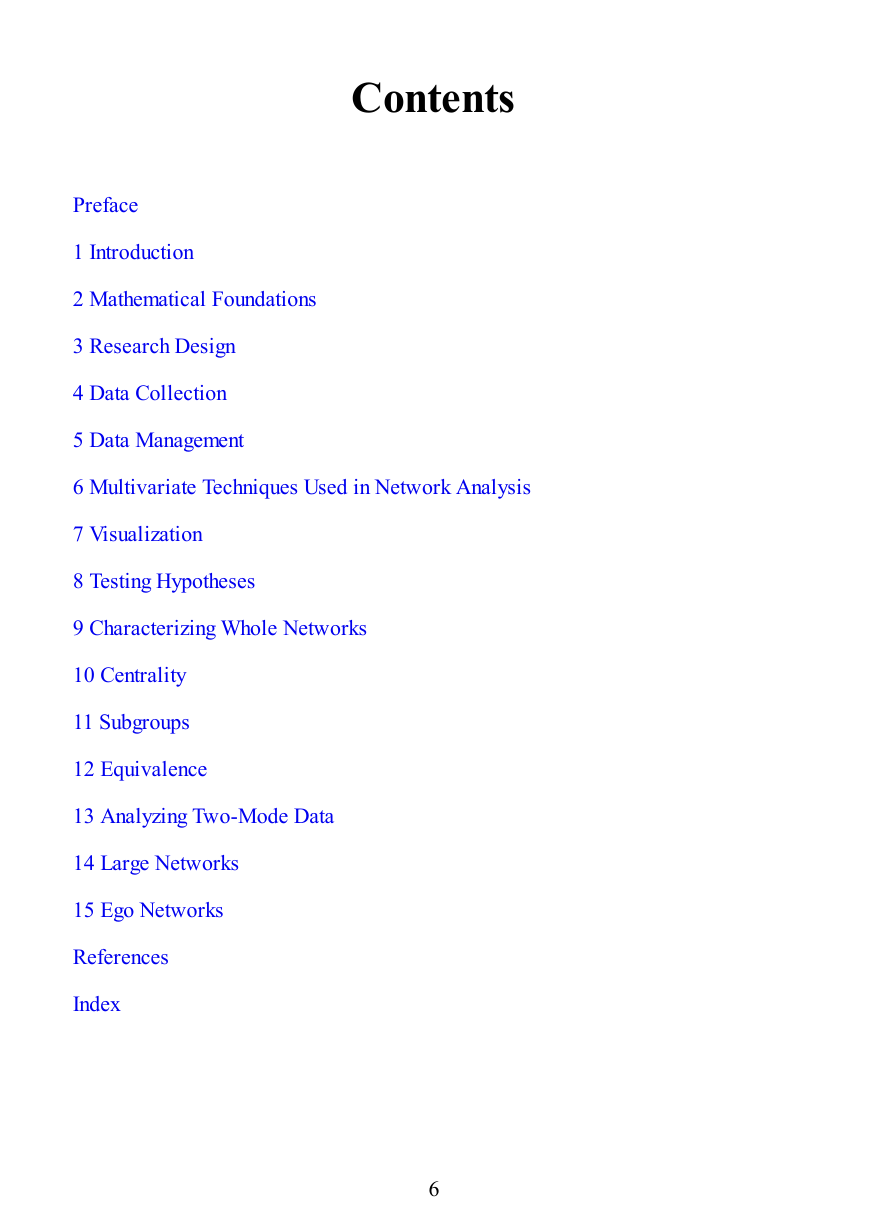
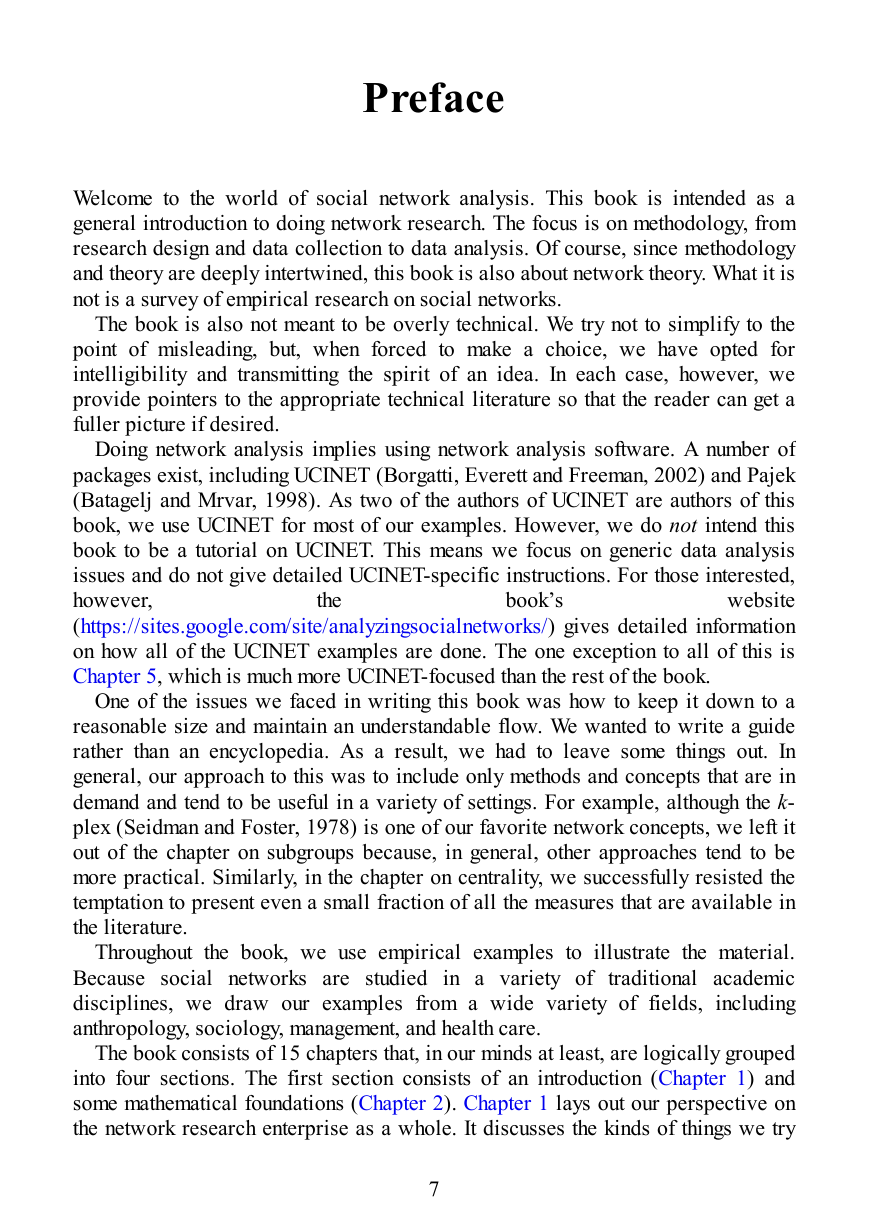
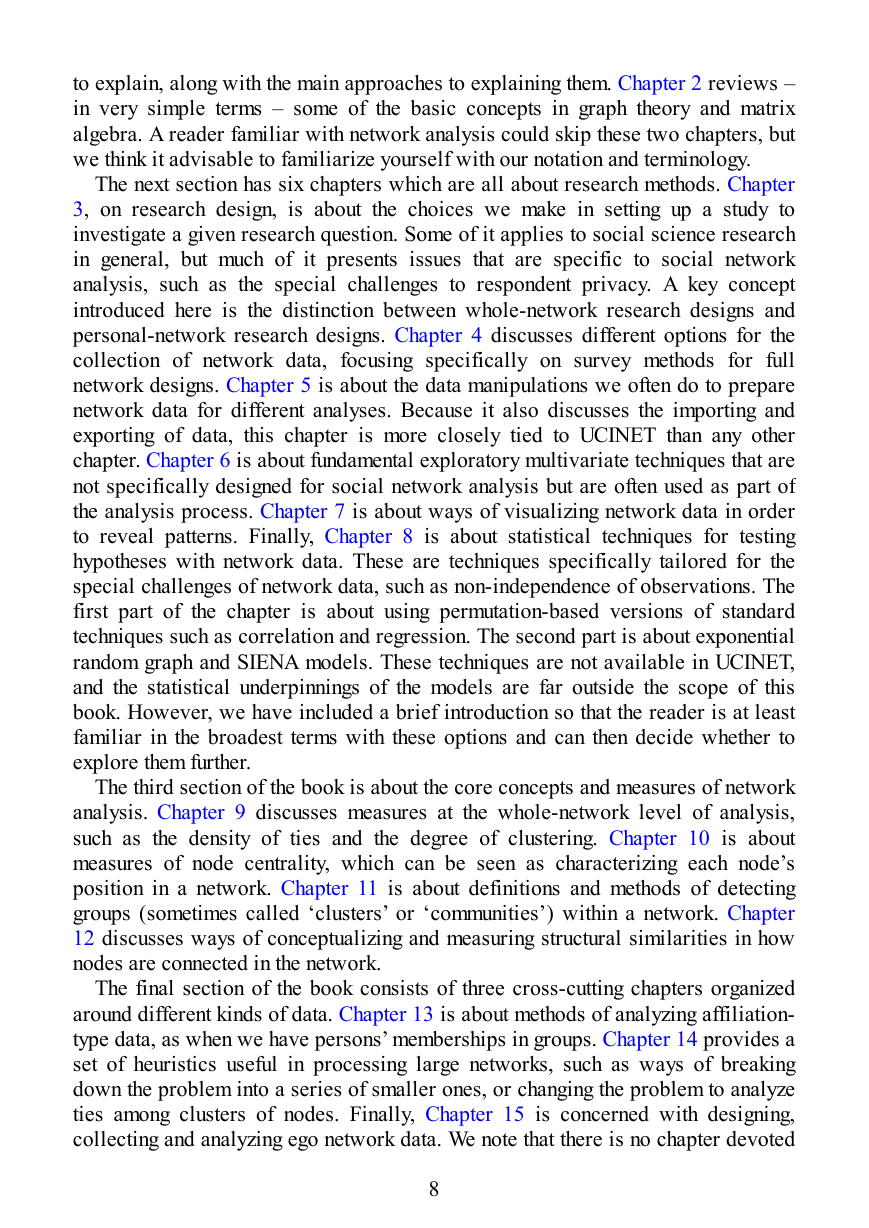








 2023年江西萍乡中考道德与法治真题及答案.doc
2023年江西萍乡中考道德与法治真题及答案.doc 2012年重庆南川中考生物真题及答案.doc
2012年重庆南川中考生物真题及答案.doc 2013年江西师范大学地理学综合及文艺理论基础考研真题.doc
2013年江西师范大学地理学综合及文艺理论基础考研真题.doc 2020年四川甘孜小升初语文真题及答案I卷.doc
2020年四川甘孜小升初语文真题及答案I卷.doc 2020年注册岩土工程师专业基础考试真题及答案.doc
2020年注册岩土工程师专业基础考试真题及答案.doc 2023-2024学年福建省厦门市九年级上学期数学月考试题及答案.doc
2023-2024学年福建省厦门市九年级上学期数学月考试题及答案.doc 2021-2022学年辽宁省沈阳市大东区九年级上学期语文期末试题及答案.doc
2021-2022学年辽宁省沈阳市大东区九年级上学期语文期末试题及答案.doc 2022-2023学年北京东城区初三第一学期物理期末试卷及答案.doc
2022-2023学年北京东城区初三第一学期物理期末试卷及答案.doc 2018上半年江西教师资格初中地理学科知识与教学能力真题及答案.doc
2018上半年江西教师资格初中地理学科知识与教学能力真题及答案.doc 2012年河北国家公务员申论考试真题及答案-省级.doc
2012年河北国家公务员申论考试真题及答案-省级.doc 2020-2021学年江苏省扬州市江都区邵樊片九年级上学期数学第一次质量检测试题及答案.doc
2020-2021学年江苏省扬州市江都区邵樊片九年级上学期数学第一次质量检测试题及答案.doc 2022下半年黑龙江教师资格证中学综合素质真题及答案.doc
2022下半年黑龙江教师资格证中学综合素质真题及答案.doc